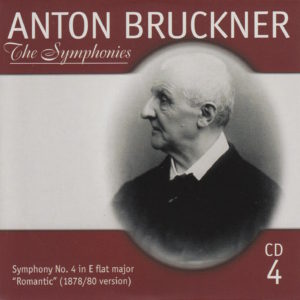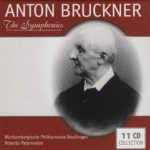 This morning’s conductor of Anton Bruckner’s Symphony No. 4 in E Flat Major (WAB 104), titled “Romantic” by Bruckner himself, is Vienna-born Roberto Paternostro (1957?-), another person about whom I knew nothing and of whom I had never heard until I started this project.
This morning’s conductor of Anton Bruckner’s Symphony No. 4 in E Flat Major (WAB 104), titled “Romantic” by Bruckner himself, is Vienna-born Roberto Paternostro (1957?-), another person about whom I knew nothing and of whom I had never heard until I started this project.
And, truth be told, still know very little about since there’s scant scraps of information about him anywhere online.
If you recall (And why should you? And who are you, anyway?), this is the conductor about whom I wrote he needed a publicist. He’ll never reach Karajan status if people don’t know who he is.
 I first encountered Mr. Paternostro on Day 11 of my 144-day journey. After that, I heard him on Day 27 and on Day 43. So this is the fourth time I’ll be listening to Maestro Paternostro’s work at the podium.
I first encountered Mr. Paternostro on Day 11 of my 144-day journey. After that, I heard him on Day 27 and on Day 43. So this is the fourth time I’ll be listening to Maestro Paternostro’s work at the podium.
But before I get too subjective about this morning’s recording, here are the nuts and bolts:
Bruckner’s Symphony No. 4 in E Flat Major composed in 1874
Roberto Paternostro conducts
Paternostro used the 1878/1880 version, edited by…whom?
Wurttembergische Philharmonie Reutlingen plays
The symphony clocks in 67:12
This was recorded Basilika Weingarten, Germany, in July of 1999
Paternostro was 42 when he conducted it
Bruckner was 50 when he composed it
This recording was released on the SWR label
Of the 1878/1880 version, its entry on Wikipedia tells us this:
1880 version (aka 1878/1880)
After the lapse of almost a year (during which he composed his String Quintet in F Major), Bruckner took up his Fourth Symphony once again. Between 19 November 1879 and 5 June 1880 he composed a new finale – the third, though it shares much of its thematic material with the first version – and discarded the Volksfest finale. Thus the 1880 version is the same as the 1878 version but with a new finale. This was the version performed at the work’s premiere on 20 February 1881, which was the first premiere of a Bruckner symphony not to be conducted by Bruckner himself. This version is sometimes referred to as the 1878/80 version.
No mention of the name Nowak on the CD sleeve from Paternostro’s box set. There’s no booklet, no liner notes, in this set at all. I hate that.
Bruckner wrote his symphonies in four parts. The time breakdown of this one (Symphony No. 4 in E Flat Major, 1878/1880 version), from this particular conductor (Paternostro) and this particular orchestra (Wurttembergische Philharmonie Reutlingen) is as follows:
I. Bewegt, nicht zu schnell (With motion, not too fast) (E-flat major)…………..17:36
II. Andante, quasi allegretto (C minor)…………………………………………………………14:49
III. Scherzo. Bewegt (With motion) – Trio: Nicht zu schnell (Not too fast) (B-flat major)……………………………………………………………………………………………………………..11:10
IV. Finale: Bewegt, doch nicht zu schnell (With motion, but not too fast) (E-flat major)………………………………………………………………………………………………………………23:40
Total running time: 67:12
Okay. Now for the subjective stuff…
My Rating:
Recording quality: 4 (lots of ambient sounds, especially at the start of Movement II)
Overall musicianship: 4
CD liner notes: 0 (there are none! boo! hiss!)
How does this make me feel: 5
There are some fine moments in this recording. The opening of Act I is haunting. And I even like the ambient sounds of the orchestra and/or audience. It gives this recording a feeling of realness, of being there. Admittedly, the ambient noise is distracting. There is more ambient noise in this recording than I’ve heard yet. The orchestra must have been in a fidgety mood that day. But, overall, the ambient sounds feels like they belongs there.
It’s interesting that in addition to not including liner notes in the box set, the music label is rather stingy with its own name. The name SWR can only be found on the back of the box itself. Not on the cover of the box. Not on the front of the CD sleeve. Not on the back of the CD sleeve. Once the CD sleeve is removed from the box itself, there’s no way to tell who released this box set. You’d think the label would want more people to know about them. But what do I know? I’m not a record label guru.
The horns are not too brassy, although they come close in Movement III (Scherzo). The “Hunt” theme is lively and engaging. The pizzicato is fun, as it almost always is. And the Finale is energetic and grand.
I didn’t even mind the applause in this recording, despite the fact that it started tentatively and didn’t reach its full power for quite awhile after the music stopped. (The last note echoes away by about 20:34 and the applause doesn’t begin until 20:42. Then it lasts until 23:35 – nearly three full minutes. That’s a lot of applause.)
Yet, by the end of the Finale I, too, felt like applauding.
I felt like bursting forth with a hearty “Huzzah!”
So I did.
